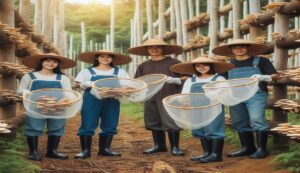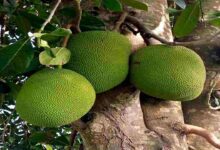Pest Control in Mushroom Farming: The best method for managing illnesses and pests in mushrooms is to use natural and organic therapies
Pest Control in Mushroom Farming: Numerous pests and illnesses pose a threat to the delicate balance between science and nature that is mushroom production. This blog explains about the many kinds of mushrooms, their nutritional value, and the common problems with pests and illnesses during growing. Take a tour through the nuances of mushroom growing while learning about efficient natural and organic pest and disease control techniques.

How to Keep Diseases and Pests Out of Mushrooms
Varieties of mushrooms
Paddy Straw Mushroom (Volvariella sp.)
Oyster Mushroom (Pleurotus sp.)
Button Mushroom (Agaricus sp.)
Milky Mushroom (Calocybe sp.)
Shiitake Mushroom (Lentinus sp.)
Jew’s Ear Mushroom (Auricularia sp.)
Typical Diseases and Pests of Mushrooms
The quality and quantity of crops may be greatly impacted by pests and diseases that affect mushrooms, especially white button mushrooms. Verticillium dry bubble, the most common fungal illness, appears as globe-shaped clumps of mushroom tissue. Using strains that are readily managed, minimizing spawn proliferation, and maintaining cleanliness are all essential components of effective management.
Green mold problems are a common issue that impact shiitake, Agaricus, and Pleurotus mushrooms. Recognized by a coating of mycelium on the casing surface that changes from white to green, it presents a significant risk to yield. Sturdy green mold management techniques are essential for long-term mushroom production.
Infestations of Flies
Fly Types: Phorid and Sciarid
The mushroom business faces considerable hurdles from phiarid and sciarid insects. The aroma of developing mycelium attracts female phorid flies, who deposit their eggs in compost or casing. They need careful control, even if their exact effect on agricultural economics is yet unknown. Mycelium is the food source for sciarid larvae, which harm mushroom tissue. Although adult sciarid flies do not directly damage mushrooms, they may transmit infections, which highlights the need of effective control techniques.
Techniques of Management
Although phorid flies are more numerous than sciarid flies, they do less harm to mushroom harvests overall. Reducing the financial effect of fly infestations requires the use of efficient management techniques, such as those described in Penn State Extension’s On-Farm Management of Phorid Fly Infestations.
IPM Practices for Integrated Pest Management (IPM) in the Production of Mushrooms
Integrated Pest Management (IPM) techniques are essential for stopping the spread of pests and preserving the amount and quality of agricultural output. IPM relies heavily on exclusion measures, which stop pests from getting into new areas or from leaving ones they already inhabit. Penn State Extension’s PA Mushroom Integrated Pest Management Handbook is an invaluable tool that provides both producers and researchers with theoretical understanding and useful advice.
A farmer is carrying a large plastic oyster mushroom.
Utilizing Sanitizers and Disinfectants
Different Roles
Despite their frequent interchangeability, disinfectants and sanitizers have different functions in the mushroom industry. Disinfectants, which are often used in picking halls and breezeways, target microorganisms that spread illness. Growers need to be cautious when selecting disinfectants because of their possible corrosiveness and efficacy.
Sanitizers for Security
Sanitizers try to lower, not always completely eradicate, germs to levels that are safe according to health regulations. Sanitizers are essential for maintaining hygiene standards and may be divided into non-food-contact and food-contact categories. Growers should take into account the unique application needs and restrictions while choosing sanitizers for various regions inside the mushroom-producing facility.
Insect Pests in the Cultivation of Mushrooms
Fly
Megaselia halterata and Megaselia tamilnodolensis are phorid flies.
Lycoriella malli, a sciarid fly
Damage: Rotten patches are caused by larvae feeding on mycelium. illness transmission across beds.
Ideal conditions are 16–24 °C and 70% or higher moisture content.
Insects
Sacphiso Manigrofaceatum, Black Beetle
Sacphiso mapictummotschulsky, the brown beetle
Damage: Spreads bacterial blotch disease and feeds on buds and mature mushrooms.
Prevention: Apply 0.1% formalin to newspaper and fix insect-proof netting.
Poppies/Columbolas
Isotoma simplex and Lepidocyrtus cyaneus
Damage: Consume the buds and mycelium.
Nematodes
Aphelenchoides composition and Ditylenchus mycelophagus
Prevention: Steer clear of extra water and keep the moisture content of your bed between 60 and 65%.
Tarsonemid mites Mite: T. floriculus and Tarsonemus myceliophagus
Tyrophagus lintneri and T. longior Are Tryoglyphid Mite
Integrated pest management techniques for prevention.
Management of Integrated Pests (IPM)
Maintain 60–65% dampness in the bed.
Put in insect-proof netting.
Use 0.1% formalin to treat newspaper used in button mushroom growing.
To attract flies, set up white bug traps.
Use dichlorvos or malathion for pest management in a safe manner.
Ink Cap (Coprinus comatus) Mushroom Cultivation: Weeds, Molds, and Diseases
Management: Get rid of contaminated bedding very soon and stay away from chemical sterilization.
The Trichoderma viride green molds
Handle with care: Change out unhealthy straws, regulate moisture, and get rid of sick beds right away.
Fungal-Related Mushroom Diseases
Verticillium malthousei and V. psalliotae Dry Bubble
Pseudobalsamia microspora, or truffle
Cobbweb/mildew (Dactylium dendroides)
Management: Prepare beds and manage moisture according to best procedures.
Pseudomonas tolassi: bacterial blotch, bacterial pit, and brown blotch
Management strategies include reducing the number of Tyroglyphus mites, avoiding overwatering, periodically removing affected beds, and using a powder solution for water bleaching.
Pathogens in Mushrooms
Dieback disease, X-disease, Brown disease, and Watering Stipe
Symptoms: early veil opening; mushrooms shaped like drumsticks.
Management: Pay close attention to diagnosis, deal with environmental issues, and concentrate on increasing production.
Utilize Natural Solutions to Manage Pests and Illnesses in Mushrooms
Grown professionally or at home, mushrooms are a tasty and healthy food crop. On the other hand, they are vulnerable to a wide range of illnesses and pests, including as rots, worms, flies, mites, and slugs. It is advised to employ natural solutions that are safe for the environment and human health to address these problems.
Good hygiene, the use of resistant varieties, the introduction of beneficial organisms such as lacewings, ladybugs, predatory mites, or parasitic wasps, the use of botanical extracts with insecticidal, fungicidal, or repellent properties, and the use of physical barriers such as nets, screens, covers, or traps are some of these techniques.
These techniques assist in lowering the insect population without endangering the mushrooms. Additionally, pests may be kept away from the mushrooms by using essential oils such as peppermint, lavender, or rosemary. All things considered, using these organic techniques may assist in preserving the caliber and productivity of your mushrooms.
Install Barriers and Traps to Keep Insects Out of mushroom-growing areas.
It is important to install barriers and traps in areas used for mushroom cultivation to avoid insect invasion. In order to prevent flies from harming the mycelium, caps, and stems of mushrooms and spreading diseases like mildew and blotches, fly traps such as sticky, baited, electric, or light traps may be used. These traps may be baited with fluids, covered in a sticky material, electrified upon contact, or enticed with light.
The use of mite barriers, such as sulfur powder, lime powder, or diatomaceous earth (DE), may help manage mites, which can lead to poor quality, lower yield, and stunted development. While lime powder is an acidic chemical that burns mites’ skin to death, DE is a fine powder made from fossilized algae. Toxic in nature, sulfur powder suffocates mites and prevents fungi from growing. To build a barrier against mites, scatter these barriers on the substrate surface or around mushroom beds.
Utilize Natural Fungicides to Control Mushroom Illnesses
To treat fungal illnesses, use organic fungicides. Among the most prevalent illnesses affecting mushrooms are verticillium wilt, cobweb mold, green mold, dry bubble, wet bubble, and bacterial blotch. If you don’t treat these illnesses correctly, they may spread swiftly and destroy your crop.
Using organic fungicides that are healthy for the environment and mushrooms is one method of preventing and controlling these infections. Baking soda, vinegar, hydrogen peroxide, potassium bicarbonate, and garlic extract are a few examples of organic fungicides. To eradicate or stop the development of the pathogens, these fungicides may be sprayed or applied to the substrate or the mushrooms.
Control Pests and Diseases in Mushrooms using Essential Oils
Control pests and illnesses in mushrooms by using essential oils. Natural plant extracts known as essential oils have a range of qualities, including insecticidal, antiviral, antibacterial, and repellant. Neem oil, peppermint oil, tea tree oil, lavender oil, rosemary oil, eucalyptus oil, and clove oil are a few essential oils that may help manage pests and illnesses in mushrooms. To repel or eliminate pests and diseases, these oils may be diluted with water or carrier oils and sprayed or applied to the substrate or the mushrooms.
Ensure Proper Air Circulation to Avoid Illnesses
Ensure enough ventilation to stave off infections. In order to develop healthily and prevent asphyxia, mushrooms need air. Mold and germs may develop more easily in a damp, stagnant atmosphere caused by poor air movement. You should utilize fans, vents, windows, or other devices to induce air movement in your growing space in order to maintain proper air circulation. In order to promote airflow between your mushrooms, you should also try to avoid packing them too closely together.
Manage Humidity and Temperature to Prevent Pest and Disease Problems
Manage the humidity and temperature to prevent insect and illness problems. Depending on the species and development stage, mushrooms have different needs for humidity and temperature. Excessive heat or low humidity may stress mushrooms and increase their susceptibility to pests and illnesses.
Selecting Fully Grown Mushrooms
You should use humidifiers, dehumidifiers, heaters, coolers, thermometers, hygrometers, and other instruments to maintain the ideal conditions for your mushrooms. It’s advisable to keep an eye on the weather and modify your settings appropriately.
Increase Mushroom Vitality with Organic Items and Compost Tea
Increase mushroom health by using organic materials such as compost tea. Compost tea is a liquid fertilizer that is created by letting compost soak in water for a while. Beneficial microorganisms found in compost tea may boost the quality of the substrate or soil, as well as the development and resistance of mushrooms. Worm castings, seaweed extract, fish emulsion, molasses, alfalfa meal, blood meal, bone meal, and other organic amendments that may provide the mushrooms with nutrients and minerals are some additional organic materials that can improve their health.
Neem oil is a useful tool for managing pests in the mushroom farming industry.
In the case of mushroom cultivation, neem oil may be a useful pest management tool. Neem oil, which possesses insecticidal and repellant qualities, is derived from neem seeds. Neem oil is effective against a range of pests that are known to damage mushrooms, including slugs, snails, mites, nematodes, sciarid flies, and fungus gnats. To kill or repel pests, neem oil may be diluted with water soap and sprayed or applied to the mushrooms or substrate.
Implement Quarantine Measures to Prevent Pests and Diseases
Implement quarantine procedures to keep illnesses and pests at bay. Measures known as quarantine are used to keep suspected or diseased materials apart from uncontaminated ones in order to stop the spread of illnesses and pests. Among the quarantine measures are:
Tools, containers, gloves, clothes, shoes, and other items specific to handling contaminated materials should be kept separate.
Dispose of contaminated items appropriately.
After usage, sterilize or disinfect instruments and equipment.
properly cleaning your hands both before and after handling things.
Separating newly acquired materials from previously acquired materials until they are examined or confirmed.
Quickly reporting any indications of an infestation or illness.
Be Aware of Insects and Illnesses and Take Early Action
Be vigilant about illnesses and pests, and take prompt action when necessary. Preventing pests and illnesses from developing in the first place is the best approach to controlling them in mushrooms. If you run into any issues, however, you should take swift action to address them before they become worse.
Organic Farms for Oyster Mushroom Cultivation
Regular inspection is necessary to check for damage, discoloration, deformation, wilting, rotting, and other symptoms associated with insect or disease attacks. As quickly as feasible, you should also determine the root of the issue and implement the proper remedy or control measure. To aid in situational monitoring and outbreak prevention in the future, you should also maintain documentation of your observations and actions.
In summary
Using organic and natural therapies is a comprehensive strategy to protect mushrooms from pests and illnesses. Growers cultivate a balanced production environment by giving priority to sustainable and chemical-free solutions. This proactive approach ensures long-term success by maintaining the health of the mushroom crop and adhering to environmentally friendly agricultural methods.

